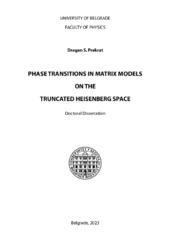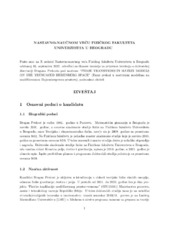Приказ основних података о дисертацији
Phase transitions in matrix models on the truncated Heisenberg space
Fazni prelazi u matričnim modelima na modifikovanom Hajzenbergovom prostoru
| dc.contributor.advisor | Burić, Maja | |
| dc.contributor.other | Radovanović, Voja | |
| dc.contributor.other | Gočanin, Dragoljub | |
| dc.contributor.other | Balaž, Antun | |
| dc.creator | Prekrat, Dragan | |
| dc.date.accessioned | 2023-09-06T11:04:35Z | |
| dc.date.available | 2023-09-06T11:04:35Z | |
| dc.date.issued | 2023-03-03 | |
| dc.identifier.uri | https://uvidok.rcub.bg.ac.rs/bitstream/handle/123456789/5260/Referat.pdf | |
| dc.identifier.uri | https://eteze.bg.ac.rs/application/showtheses?thesesId=9190 | |
| dc.identifier.uri | https://fedorabg.bg.ac.rs/fedora/get/o:30531/bdef:Content/download | |
| dc.identifier.uri | https://plus.cobiss.net/cobiss/sr/sr/bib/121785353 | |
| dc.identifier.uri | https://nardus.mpn.gov.rs/handle/123456789/21600 | |
| dc.description.abstract | In this dissertation, we study a self-interacting Hermitian matrix field in two dimensions coupled to the curvature of the noncommutative truncated Heisenberg space. In the infinite size limit, the model reduces to the renormalizable Grosse-Wulkenhaar’s. We inspect the connection between the model’s curvature term, UV/IR mixing, and renormalizability. The model is numerically simulated using the Hybrid Monte Carlo method. In order to obtain the nontrivial phase structure, we first vary the scalings of the action term parameters and inspect the transition line stability under the change of matrix size. After we fix the scalings, we proceed to construct the phase diagrams and find their large matrix size limits. As a result, we establish the presence of the three phases previously found in other matrix models — the ordered, the disordered, and a purely noncommutative striped phase. The curvature term proves crucial for the diagram’s structure: when turned off, the triple point collapses into the origin as matrices grow larger; when turned on, the triple point recedes from the origin proportionally to the coupling strength and the matrix size. We use both the field eigenvalue distribution approach and a bound on the action to predict the position of the transition lines. Their simulated curvature-induced shift convincingly agrees with our analytical results. We found that the coupling attenuation that turns the Grosse-Wulkenhaar model into a renormalizable version of the λφ4 ?-model cannot stop the triple point recession. As a result, the stripe phase escapes to infinity, removing the problems with UV/IR mixing and explaining the success of the Grosse-Wulkenhaar model. | sr |
| dc.description.abstract | U ovoj disertaciji, izučavamo samointeragujuće hermitsko matrično polje na koga deluje krivina nekomutativnog modifikovanog Hajzenbergovog prostora. U limesu beskonačnih matrica, ovaj model se svodi na renormalizabilni Grose-Vulkenharov. Cilj je da se ispita veza između člana sa krivinom, UV/IR mešanja i renormalizabilnosti modela. Numeričkoj simulaciji modela smo pristupili Hibridnim Monte Karlo metodom. Radi do- bijanja netrivijalne strukture faznog dijagrama, prvo variramo skaliranje parametara članova u dejstvu i ispitujemo stabilnost linija faznih prelaza pri promeni veličine matrica. Nakon što smo fiksirali skaliranje, konstruišemo fazne dijagrame i nalazimo njihove limese. Na ovaj način smo utvrdili pristustvo tri faze prethodno detektovane kod drugih matričnih modela — uređene, neuređene i čisto nekomutativne trakaste faze. Član sa krivinom se pokazao presudnim po strukturu dijagrama: kada je uključen, trojna tačka modela kolapsira u koordinatni početak prostora parametara s povećanjem formata matrica; kada je isključen, trojna tačka se udaljava od koordinatnog početka srazmerno parametru krivine i veličini matrice. Za predviđanje položaja linija faznih prelaza, koristili smo metod raspodela svojstvenih vrednosti polja kao i procenjivanje granica na vrednosti samog dejstva. Simulirane vrednosti ovog krivinom izazvanog pomeranja se ubedljivo slažu sa našim analitičkim rezultatima. Brizina isključivanja parametra krivine koje pretvara Grose-Vulkenharov model u re- normalizabilnu verziju λφ4 ? modela je nedovoljna da zaustavi udaljavanje trojne tačke od koordinatnog početka. Posledica toga je da trakasta faza nestaje u beskonačnosti, rešavajući problem UV/IR mešanja, čime smo objasnili uspešnost Grose-Vulkenharovog modela. | en |
| dc.format | application/pdf | |
| dc.language | sr | |
| dc.publisher | Универзитет у Београду, Физички факултет | sr |
| dc.rights | openAccess | en |
| dc.rights.uri | https://creativecommons.org/licenses/by/4.0/ | |
| dc.source | Универзитет у Београду | sr |
| dc.subject | Noncommutative geometry | sr |
| dc.subject | Nekomutativna geometrij | en |
| dc.subject | Grosse-Wulkenhaar model | sr |
| dc.subject | Matrix models Phase transitio | sr |
| dc.subject | Renormalizability | sr |
| dc.subject | Monte Carlo simulations | sr |
| dc.subject | Grose-Vulkenharov model | en |
| dc.subject | Matrični modeli Fazni prela | en |
| dc.subject | Renormalizabilnost | en |
| dc.subject | Monte Karlo simulacije | en |
| dc.title | Phase transitions in matrix models on the truncated Heisenberg space | sr |
| dc.title.alternative | Fazni prelazi u matričnim modelima na modifikovanom Hajzenbergovom prostoru | en |
| dc.type | doctoralThesis | |
| dc.rights.license | BY | |
| dc.identifier.fulltext | http://nardus.mpn.gov.rs/bitstream/id/151718/Disertacija_13651.pdf | |
| dc.identifier.fulltext | http://nardus.mpn.gov.rs/bitstream/id/152436/Referat.pdf | |
| dc.identifier.rcub | https://hdl.handle.net/21.15107/rcub_nardus_21600 |



